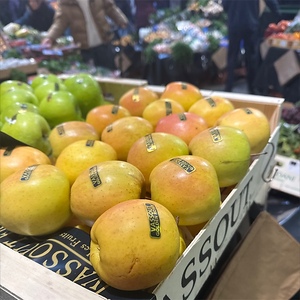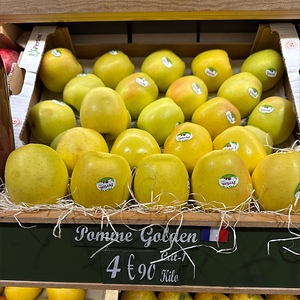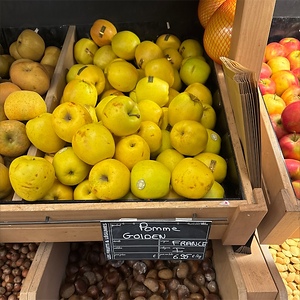


Golden Limousin Apples
Estimated Inventory, lb : 0
Description/Taste
Golden Limousin apples vary in size and shape, depending on seasonal growing conditions, and are required to have a minimum size of 6.5 centimeters and a weight of 115 grams. The apples range from round to conical and sometimes have an elongated appearance with flat, broad shoulders tapering to a narrow base. The fruit’s surface is smooth to slightly ribbed and has thin, taut skin covered in patches of textured brown russet and prominent dark lenticels. Golden Limousin apples ripen to shades of yellow and white-green. It is important to note that fruits can be ripe in their white-green stage, so color cannot always determine maturity. White-green apples will be more crunchy, while golden yellow apples will have a softer feel. The apples are also occasionally flushed with red-pink blush spots. This colored pigmentation naturally occurs when the weather fluctuates from warm days to cold nights in the apple’s growing region. Underneath the surface, the white flesh is compact, firm, fine-grained, and aqueous, with a crisp and crunchy consistency. The flesh also encases a small central core filled with tiny dark brown-black seeds. Golden Limousin apples emit a subtle, honeyed aroma when ripe and have a balanced blend of sugar and acidity, creating a mild, sweet, tangy, fruity, and floral taste.
Seasons/Availability
Golden Limousin apples are harvested in the fall in France, typically between mid-September and October. Once picked, the apples are professionally kept in cold storage for sale in markets between November and July.
Current Facts
Golden Limousin apples, botanically classified as Malus domestica, are a geographically protected variety belonging to the Rosaceae family. The apples are unique to the Limousin region of France and are the only type in the country with an AOP or PDO, a Protected Designation of Origin. Golden Limousin apples are Golden Delicious apples marketed under a separate name to showcase their distinctive qualities from other yellow commercial apples. They are also known as Pomme du Limousin AOP or Pomme du Limousin PDO in France. The Limousin-grown apples typically exhibit an elongated shape and have a firmer consistency. Golden Limousin apples also develop a characteristic pink blush from being grown in high-altitude regions. When in season, Golden Limousin apples are picked by hand and transported within forty-eight hours to cold rooms for storage. The protected apples are sold throughout Europe as specialty fruits valued for their long shelf life. Chefs and home cooks choose Golden Limousin apples for their versatility in fresh and cooked culinary preparations.
Nutritional Value
Golden Limousin apples are a source of calcium and phosphorus to support bone and teeth development and potassium to balance fluid levels in the body. Apples also provide fiber to stimulate the digestive tract for natural cleansing, magnesium to control nerve functions, and other minerals like iron, manganese, copper, and zinc. Beyond minerals, apples contain vitamins A, C, and E to strengthen the immune system, maintain healthy organs, and guard the cells against the damage caused by free radicals. Apples also provide folate to help the body produce red blood cells and anthocyanins, which have antioxidant properties to reduce inflammation and support overall bodily health.
Applications
Golden Limousin apples have a mild, sweet, and subtly tangy taste suited for fresh and cooked preparations. The fruits can be used in any recipe calling for Golden Delicious apples and are popularly eaten out of hand for their floral and fruity flavor. Golden Limousin apples are sliced and served on charcuterie boards or tossed into salads and slaws. They are also cut and layered into sandwiches, chopped as a topping for bruschetta, or served as an accompaniment to breakfast dishes like crepes, oatmeal, and pancakes. Try blending Golden Limousin apples into juices, smoothies, or shakes for a sweet, refreshing beverage. Golden Limousin apples are also incorporated into sweet or savory culinary dishes and are known for holding their shape when cooked. The variety is popularly roasted and served with meats like duck, pork, pheasant, and poultry in France. Golden Limousin apples are also eaten with foie gras, cooked with shredded cabbage, fried into fritters, or added to gratins. In addition to savory dishes, Golden Limousin apples are baked into galettes, cookies, muffins, crumbles, tarts, cakes, and pies. They are also stuffed and baked whole, wrapped in pastry dough, fried and served with vanilla ice cream, or used as fillings for various desserts. French chefs sometimes used the specialty apples as a base in sauces, compotes, and jams. Golden Limousin apples pair well with honey, brown sugar, fruits such as raspberries, oranges, and pears, spices including nutmeg, cinnamon, and ginger, almonds, and cheeses like goat, Manchego, Camembert, and cheddar. Whole, unwashed Golden Limousin apples will last for 1 to 2 weeks when stored in the refrigerator’s crisper drawer.
Ethnic/Cultural Info
Golden Limousin apples received their protected status from the unique growing conditions present on the Haut-Limousin Plateau, also known as the Plateau de Millevaches. This high-altitude region is in the foothills of the Massif Central and reaches 300 to 500 meters in elevation. The plateau is known for having a humid climate with varying temperatures between day and night. These temperature swings contribute to the apple’s distinct, pink-blushed coloring and the flesh’s firm, crisp nature. Orchards planted on the plateau are also filled with naturally fertile soil that can retain water after rainfall, an ideal combination for apple growth. Golden Limousin apples are annually celebrated through the Route de la Pomme du Limousin AOP in the summer. The route changes each year throughout the Limousin region and is used to promote Golden Limousin apples to the public through apple festivals, hikes, tastings, and orchard tours. There is also a museum called the Maison de la Pomme du Limousin in the commune of Lanouille in Dordogne, where visitors can learn about the history and production of the AOP variety.
Geography/History
Golden Limousin apples are the marketing name for Golden Delicious apples grown in a protected geographical region of France. Golden Delicious apples are native to the United States and were discovered growing as a chance seedling in the late 19th century in the Mullins family orchard of Odessa in Clay County, West Virginia. Mr. Anderson H. Mullins eventually wrote a letter and sent three sample apples to Stark Bro’s Nursery in Louisiana, Missouri, a major commercial nursery at the time. The samples were received in 1914, and after trying the apples, Paul Clarence Stark Sr. embarked on an extensive journey by horseback and rail to acquire the rights to the golden fruits. Stark Bro’s Nursery released the apples commercially under the name Golden Delicious, and the variety quickly became a successful cultivar. Golden Delicious apples were planted in the Limousin region of France by businessman and apple grower Guy Chauffaille in the 1950s. A few years later, in 1958, Chauffaille partnered with arboriculturist André Michon and planted more Golden Delicious apples in the orchard of Domaine de la Meynie in Dordogne, France. Golden Delicious apples thrived in the Limousin’s unique microclimate and fertile soil, and over time, more producers began growing the variety. In the 1990s, Limousin apple growers applied for an Appellation d'Origine Contrôlée or AOC to help distinguish their apples from Golden Delicious apples grown in other regions of France and Europe. The first request was submitted in 1992, and after several years of investigations and evaluations, the Institut National des Appellations d'Origine or INAO granted Limousin apples an AOC in 2005 under the name Pomme du Limousin. The variety was later awarded an AOP or PDO, Protected Designation of Origin, by the European Union in 2007, which replaced its AOC label. Today, Golden Limousin apples are grown within one hundred municipal areas within the departments of Corrèze, Creuse, Nord-Dordogne, and Haute-Vienne in France's Limousin and Aquitaine regions. The apples are also only marketed by four major companies in France, including Meylim, Limdor, Perlim, and Cooplim, and are sold throughout Europe in specialty markets.










